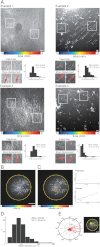Confinement induces actin flow in a meiotic cytoplasm
- PMID: 22753521
- PMCID: PMC3406835
- DOI: 10.1073/pnas.1121583109
Confinement induces actin flow in a meiotic cytoplasm
Abstract
In vivo, F-actin flows are observed at different cell life stages and participate in various developmental processes during asymmetric divisions in vertebrate oocytes, cell migration, or wound healing. Here, we show that confinement has a dramatic effect on F-actin spatiotemporal organization. We reconstitute in vitro the spontaneous generation of F-actin flow using Xenopus meiotic extracts artificially confined within a geometry mimicking the cell boundary. Perturbations of actin polymerization kinetics or F-actin nucleation sites strongly modify the network flow dynamics. A combination of quantitative image analysis and biochemical perturbations shows that both spatial localization of F-actin nucleators and actin turnover play a decisive role in generating flow. Interestingly, our in vitro assay recapitulates several symmetry-breaking processes observed in oocytes and early embryonic cells.
Conflict of interest statement
The authors declare no conflict of interest.
Figures




References
-
- Li H, Guo F, Rubinstein B, Li R. Actin-driven chromosomal motility leads to symmetry breaking in mammalian meiotic oocytes. Nat Cell Biol. 2008;10:1301–1308. - PubMed
-
- Azoury J, et al. Spindle positioning in mouse oocytes relies on a dynamic meshwork of actin filaments. Curr Biol. 2008;18:1514–1519. - PubMed
-
- Schuh M, Ellenberg J. A new model for asymmetric spindle positioning in mouse oocytes. Curr Biol. 2008;18:1986–1992. - PubMed
-
- Pollard TD, Borisy GG. Cellular motility driven by assembly and disassembly of actin filaments. Cell. 2003;112:453–465. - PubMed
Publication types
MeSH terms
Substances
LinkOut - more resources
Full Text Sources

